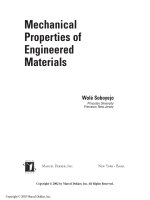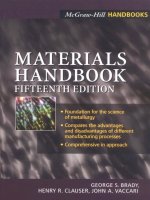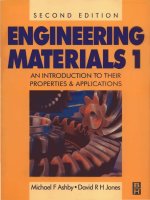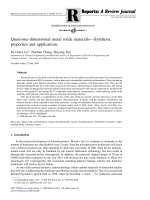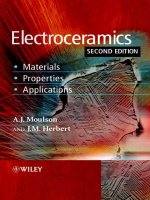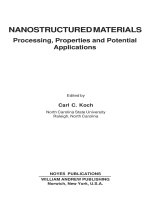electroceramics materials properties applications
Bạn đang xem bản rút gọn của tài liệu. Xem và tải ngay bản đầy đủ của tài liệu tại đây (5.08 MB, 578 trang )
Electroceramics
Second Edition
Materials Á Properties Á Applications
A. J. Moulson
and
J. M. Herbert
Electroceramics
Second Edition
Electroceramics
Second Edition
Materials Á Properties Á Applications
A. J. Moulson
and
J. M. Herbert
Copyright u 2003 John Wiley & Sons Ltd, The Atrium, Southern Gate, Chichester,
West Sussex PO19 8SQ, England
Telephone (+44) 1243 779777
Email (for orders and customer service enquiries):
Visit our Home Page on www.wileyeurope.com or www.wiley.com
All Rights Reserved. No part of this publication may be reproduced, stored in a retrieval system or
transmitted in any form or by any means, electronic, mechanical, photocopying, recording, scanning or
otherwise, except under the terms of the Copyright, Designs and Patents Act 1988 or under the terms of a
licence issued by the Copyright Licensing Agency Ltd, 90 Tottenham Court Road, London W1T 4LP,
UK, without the permission in writing of the Publisher. Requests to the Publisher should be addressed to
the Permissions Department, John Wiley & Sons Ltd, The Atrium, Southern Gate, Chichester, West
Sussex PO19 8SQ, England, or emailed to , or faxed to (+44) 1243 770571.
This publication is designed to provide accurate and authoritative information in regard to the subject
matter covered. It is sold on the understanding that the Publisher is not engaged in rendering professional
services. If professional advice or other expert assistance is required, the services of a competent
professional should be sought.
Other Wiley Editorial Offices
John Wiley & Sons Inc., 111 River Street,
Hoboken, NJ 07030, USA
Jossey-Bass, 989 Market Street,
San Francisco, CA 94103-1741, USA
Wiley-VCH Verlag GmbH, Boschstr. 12,
D-69469 Weinheim, Germany
John Wiley & Sons Australia Ltd, 33 Park Road,
Milton, Queensland 4064, Australia
John Wiley & Sons (Asia) Pte Ltd, 2 Clementi Loop #02-01,
Jin Xing Distripark, Singapore 129809
John Wiley & Sons Canada Ltd, 22 Worcester Road,
Etobicoke, Ontario, Canada M9W 1L1
Library of Congress Cataloging-in-Publication Data
British Library Cataloguing in Publication Data
A catalogue record for this book is available from the British Library
ISBN 0471 49747 9 (hardback)
ISBN 0471 49748 7 (paperback)
Typeset by Dobbie Typesetting Ltd, Tavistock, Devon
Printed and bound in Great Britain by T.J. International, Padstow, Cornwall
This book is printed on acid-free paper responsibly manufactured from sustainable forestry
in which at least two trees are planted for each one used for paper production.
CONTENTS
Preface xi
Acknowledgements xv
Glossary xvii
1: Introduction 1
2: Elementary Solid State Science 5
2.1 Atoms 5
2.2 The arrangement of ions in ceramics 10
2.3 Spontaneous polarization 17
2.4 Phase transitions 19
2.5 Defects in crystals 20
2.5.1 Non-stoichiometry 20
2.5.2 Point defects 21
2.6 Electrical conduction 24
2.6.1 Charge transport parameters 24
2.6.2 Electronic conduction
2.6.3 Ionic conduction 43
2.6.4 Summary
2.6.5 Schottky barriers to conduction 48
2.7 Charge displacement processes 52
2.7.1 Dielectrics in static electric fields 52
2.7.2 Dielectrics in alternating electric fields 60
2.7.3 Barium titanate – the prototype ferroelectric ceramic 71
2.7.4 Mixtures of dielectrics
Problems 90
Bibliography 92
3: Processing of Ceramics 95
3.1 General 95
3.2 Cost 96
3.3 Raw materials
3.4 Powder preparation – mixing and grinding 97
3.4.1 The ‘mixed oxide’ or solid state route 100
3.4.2 The oxalate route 100
3.4.3 The alkoxide route 101
3.4.4 Hydrothermal synthesis 101
Electroceramics: Materials, Properties, Applications. 2nd Edition. Edited by A. J. Moulson and J. M. Herbert.
& 2003 John Wiley & Sons, Ltd: ISBN 0 471 49747 9 (hardback) 0 471 49748 7 (paperback)
2
2
2.7.5Impedancespectroscopy85
96
6
47
7
3.5 Calcination 101
3.6 Shaping 103
3.6.1 Dry-pressing 104
3.6.2 Isostatic-pressing 106
3.6.3 ‘Jolleying’ 107
3.6.4 Extrusion 107
3.6.5 Colloidal processing: slip-casting 108
3.6.6 Tape-casting 109
3.6.7 Calendering and viscous polymer processing 110
3.6.8 Injection-moulding 111
3.6.9 Films and layers 111
3.7 High-temperature processing 114
3.7.1 Densification 114
3.7.2 Hot-pressing 115
3.7.3 Isostatic hot-pressing 116
3.7.4 Glass-ceramics 117
3.8 Finishing 118
3.9 Porous materials 119
3.10 Processing and electroceramics research and development 120
3.11 The growth of single crystals 121
Problems 130
Bibliography 133
4: Ceramic Conductors 135
4.1 High-temperature heating elements and electrodes
4.1.1 Silicon carbide 136
4.1.2 Molybdenum disilicide 141
4.1.3 Lanthanum chromite 141
4.1.4Tinoxide142
4.1.5 Zirconia
4.2 Ohmic resistors
4.2.2 Thick films
4.3 Voltage-dependent resistors (varistors) 150
4.3.1 Electrical characteristics and applications 150
4.3.2 Silicon carbide
4.3.3 Zinc oxide 156
4.4 Temperature-sensitive resistors 159
4.4.1 Negative temperature coefficient resistors (NTC thermistors) 160
4.4.2 Positive temperature coefficient resistors (PTC thermistors) 167
4.5 Fuel cells and batteries 173
4.5.1 The stimulus for developing fuel cells and batteries 173
4.5.2 Basics of fuel cells and batteries 176
4.5.3 Electroceramics for fuel cells and batteries 184
4.6 Ceramics-based chemical sensors 198
4.6.1 Sensors based on solid electrolytes 199
4.6.2 Gas-sensors based on electronically conducting ceramics 207
4.6.3 Humidity sensors 214
4.7 High transition temperature superconductors 217
4.7.1 Overview 217
4.7.2 The phenomenon of superconductivity 218
4.7.3 Ceramic high-T
c
superconductors (HTSs) 222
vi CONTENTS
14
135
145
4.2.1Thinfilms14
156
147
4
6
4.7.4 The properties, processing and applications of HTSs 225
4.7.5 Superconducting electronics – thin films 233
4.7.6 The future for HTSs 235
Problems 236
Bibliography 240
5: Dielectrics and Insulators 243
Part I Capacitative Applications 244
5.1 Background 244
5.2 Dielectric strength 245
5.2.1 Test conditions 246
5.2.2 Breakdown mechanisms 246
5.3 Thermal shock resistance 250
5.4 Capacitors 251
5.4.1 Capacitor characteristics 251
5.4.2 Non-ceramic capacitors 256
5.4.3 Ceramic capacitors 260
Part II Principal Ceramic Types and Applications 269
5.5 Low-permittivity ceramic dielectrics and insulators 269
5.5.1 Electrical porcelains 269
5.5.2 Alumina 276
5.5.3 Beryllia 285
5.5.4 Aluminium nitride 286
5.5.5 Ceramic ‘packaging’ technology 286
5.6 Medium-permittivity ceramics 289
5.6.1 Rutile ceramic 290
5.6.2 Degradation in titanium-containing oxides 293
5.6.3 High-power capacitors 295
5.6.4 Low-TCC low-loss capacitors 297
5.6.5 Microwave ceramics 300
5.7 High-permittivity ceramics 310
5.7.1 Modified barium titanate dielectrics 311
5.7.2 Relaxor ferroelectrics 320
5.7.3 Multilayer capacitors with base metal electrodes (BME) 323
5.7.4 Barrier layer caps (Class IV) 326
5.7.5 Ferroelectric memories 329
Problems 333
Bibliography 335
6: Piezoelectric Ceramics 339
6.1 Background theory 339
6.2 Parameters for piezoelectric ceramics and their measurement 344
6.3 General characteristics and fabrication of PZT 354
6.3.1 Effects of domains 354
6.3.2 Effects of aliovalent substituents 358
6.3.3 Fabrication of PZT 361
6.4 Important commercial piezoceramics 362
6.4.1 Barium titanate 362
6.4.2 Lead zirconate–lead titanate (‘PZT’) 364
CONTENTS
vii
6.4.3 Lead-based relaxor piezoelectric and electrostrictive ceramics 366
6.4.4 Lead niobate 369
6.4.5 Lithium niobate and lithium tantalate 371
6.4.6 Piezoceramic–polymer composites 373
6.4.7 Summary of properties 379
6.5 Applications 381
6.5.1 Generation of voltages 382
6.5.2 Generation of displacement – ‘actuators’ 386
6.5.3 High frequency applications 396
6.5.4 Piezoceramic–polymer composites 402
6.5.5 Summary 402
Appendix: Piezoelectric relations for ceramics poled in the 3 direction 404
Problems 407
Bibliography 409
7: Pyroelectric Materials 411
7.1 Background 411
7.2 Infrared detection 413
7.3 Effects of circuit noise 417
7.3.1 Johnson noise 418
7.3.2 Thermal fluctuations 418
7.4 Materials 419
7.5 Measurement of the pyroelectric coefficient 422
7.6 Applications 423
7.6.1 Radiometry 424
7.6.2 Pollutant control 425
7.6.3 Intruder alarm 425
7.6.4 Thermal imaging 426
Problems 431
Bibliography 432
8: Electro-optic Ceramics 433
8.1 Background optics 433
8.1.1 Polarized light 434
8.1.2 Double refraction 437
8.1.3 The electro-optic effect 440
8.1.4 Non-linear optics 445
8.1.5 Transparent ceramics 448
8.2 Lanthanum-substituted lead zirconate titanate 449
8.2.1 Structure and fabrication 449
8.2.2 Measurement of electro-optic properties 451
8.2.3 Electro-optic characteristics 454
8.3 Applications 459
8.3.1 Flash goggles 459
8.3.2 Colour filter 460
8.3.3 Display 460
8.3.4 Image storage 461
8.3.5 PLZT films 463
8.4 Optical non-linearity in glass and glass-ceramics 464
Problems 466
Bibliography 468
viii
CONTENTS
9: Magnetic Ceramics 469
9.1 Magnetic ceramics: basic concepts 470
9.1.1 Origins of magnetism in materials 470
9.1.2 Magnetization in matter from the macroscopic viewpoint 472
9.1.3 Shape anisotrophy: demagnetisation 473
9.1.4 Magnetic materials in alternating fields 475
9.1.5 Classification of magnetic materials 477
9.1.6 The paramagnetic effect and spontaneous magnetization 479
9.1.7 Magnetocrystalline anisotropy 481
9.1.8 Magnetostriction 482
9.1.9 Weiss domains 482
9.1.10 Magnetization in a multidomain crystal 484
9.2 Model ferrites 486
9.2.1 Spinel ferrites: model NiOFe
2
O
3
486
9.2.2 Hexaferrites: model BaFe
12
O
19
489
9.2.3 Garnets: model Y
3
Fe
5
O
12
(YIG) 490
9.3 Properties influencing magnetic behaviour 492
9.3.1 Soft ferrites 492
9.3.2 Hard ferrites 505
9.3.3 Summary of properties 511
9.3.4 Microwave ferrites 511
9.4 Preparation of ferrites 517
9.4.1 Raw materials 518
9.4.2 Mixing, calcining and milling 518
9.4.3 Sintering 519
9.4.4 Single-crystal ferrites 520
9.4.5 Magnets with oriented microstructures 520
9.4.6 Finishing 521
9.5 Applications 523
9.5.1 Inductors and transformers for small-signal applications 523
9.5.2 Transformers for power applications 529
9.5.3 Antennas 530
9.5.4 Information storage and optical signal processing 532
9.5.5 Microwave devices 535
9.5.6 Permanent magnets 541
Problems 543
Bibliography 545
Index 547
CONTENTS ix
PREFACE
‘Ceramics’ describes an engineering activity embracing the design and fabrication
of ceramic components. Because the optimum physical and chemical properties
of a ceramic are defined by the specific requirements of the end use, the pursuit
is, of necessity, interdisciplinary. For example, the design and manufacture of
refractories is a challenging technology, spanning physical chemistry and
metallurgical and chemical engineering. Even greater challenges confront the
electroceramist involved in, for example, the development of the ceramic battery
or fuel cell. Here a combination of a good understanding of solid state chemical
physics with expert knowledge and experience of advanced ceramics fabrication
technologies is essential. In addition there should be a sound appreciation of the
many considerations, usually complex, concerned with ‘end use’. The same is
true of the very diverse range of types of electroceramic component discussed in
the text.
In the UK, the necessary basic disciplines, solid state chemical physics and
electrical and electronic engineering, have, in the main, attracted into higher
education those students who at school displayed strengths in mathematics,
physics and chemistry. Materials science undergraduates have tended to be more
qualitative in their approach to learning, an approach now difficult to justify and
sustain:
I often say that when you can measure what you are speaking about, and express
it in numbers you know something about it; but when you cannot measure it, when
you cannot express it in numbers, your knowledge is of a meagre and
unsatisfactory kind: it may be the beginning of knowledge, but you have
scarcely, in your thoughts advanced to the stage of science, whatever the matter
may be.
(Sir William Thomson – Lord Kelvin (1883) Electrical units of measurement
‘Popular Lectures and Addresses’ 1, Macmillan & Co. London 1989).
The electroceramist must cultivate, at an appropriate level, a quantitative
understanding of the basic science of a wide range of physical properties of
solids, including conductive, dielectric, optical, piezoelectric and magnetic. The
understanding must embrace how the science of ceramics can be exploited to
optimise properties, not only through the design of material composition, but
also through the tailoring of microstructure and texture. Because the objective
Electroceramics: Materials, Properties, Applications. 2nd Edition. Edited by A. J. Moulson and J. M. Herbert.
& 2003 John Wiley & Sons, Ltd: ISBN 0 471 49747 9 (hardback) 0 471 49748 7 (paperback)
is an improved component for some particular function – a capacitor,
thermistor, fuel cell, battery, microwave filter, chemical sensor, actuator,
etc. – there has to be an intelligent appreciation of the significance of the
various relevant properties to the particular application, and how to ‘engineer’
the material to optimise them. This is well illustrated by the piezoceramic–
polymer composites for ultrasound transducers, pyroelectric materials for
infrared detectors and imaging systems, and thin film ceramics for random
access memories. Their development demands an interplay between the basic
sciences, electronic engineering and materials science, or better, ‘materials
engineering’ – a term increasingly encountered.
Not surprisingly, most of the available texts concentrate on one or other of the
relevant basic solid state science, the ceramics science and technology, or on
component applications; the other two aspects receiving only superficial
coverage. The nearest to what might be seen as offering interdisciplinary
treatments are edited contributions from specialists in various topics. Whilst
these are valuable they may present difficulties to the undergraduate and
newcomer to the field. There are plenty of specialist papers but they are mostly
published for the benefit of those well grounded in their subjects and capable of a
balanced and critical appreciation.
In the UK, the teaching of electroceramics passed through its formative
years as a natural development of ‘traditional ceramics’ and then became
absorbed into the framework of ‘materials science’ courses. It now seems
that the very interdisciplinary nature of the topics embraced, together with
changing fashions as far as the aspirations of many young people in the
West are concerned, are having their impact and the next decade may well
see the basic science, materials and engineering communities in higher
education merging into interdisciplinary institutes of one sort or another.
The authors have very much in mind the teaching and postgraduate research
personnel in higher education and also the large community of physicists,
chemists and engineers who enter industry without the benefit of specialized
training.
A great deal has happened since the first edition was published and there is no
reason to believe that the rate of technological progress will diminish. However,
principles do not change. The authors’ objective is not to present up-to-the-
minute descriptions encompassing all of what comprises the science and
technology of electroceramics, but to concentrate on the most significant
advances, which encompass what seem to be the unchanging principles
underpinning the science, fabrication and applications of electroceramics.
However where significant developments are occurring at the subject frontiers
and about which the authors feel the well-informed electroceramist should be
aware, the coverage is sufficient to serve as a ‘lead-in’ for a more in-depth study.
This is the case with, for example, ceramics in photonics and ferroelectric
random access memories.
xii PREFACE TO SECOND EDITION
The past decade has seen significant advances in fabricating electroceramics.
For example the demand for higher volumetric efficiency multilayer capacitors
has had its impact on the technologies concerned with the preparation of
powders having closely defined chemistry and physical characteristics, and on
their processing into components. The (often overriding) need to reduce costs has
led to the widespread adoption of base metal electrodes in multilayer technology
which, in turn, has stimulated the design of special chemically modified powders.
Multilayer technology itself has penetrated many sectors of electroceramics
technology. The decade has also seen significant developments in electroceramics
associated with microwave telecommunications and the emergence of LTCC
(low temperature co-fired ceramic) technology.
Since the appearance of the first edition there has been a growing awareness of
the ‘global environment’ and of the negative impact our apparently insatiable
demand for energy is having upon it. The strong growth of interest in fuel cells
and batteries is one very important response to this. High temperature
superconductor technologies are maturing with ‘current leads’ and ‘fault current
limiters’ now commercial products. Impressive progress is being made with
regard to ‘trapped field’ magnets and these, together with superconducting
cables, are set to play important roles in the more efficient generation and
distribution of electrical energy.
To an ever-increasing extent the functioning of manufactured products from
the ‘air-bus’ and motor-car through to the ‘fridge’ and washing-machine,
depends upon ‘sensor-actuator’ technology where electroceramics play essential
roles. The technology of sensing harmful gases and of chemical sensing in general
has seen significant developments over the past decade.
In addition to covering these developments, the revision has presented the
opportunity to rectify what were identified as shortcomings of one sort or
another. Minor errors have been corrected and the discussions on many topics
modified to bring them up-to-date. The cross-referencing throughout the text has
been extended and so also has the bibliography. The review papers and texts
referenced have been carefully selected with the objective of easing entry into the
specialised literature; at the same time every effort has been taken to maintain
the essentially ‘free-standing’ character of the book. With very few exceptions,
the bibliography is restricted to ‘readily accessible’ texts and papers which are
also judged to be essential information sources for the electroceramist. The web
contains a wealth of information – some excellent in quality and some less so. In
general the authors have resisted the temptation to reference web-sites in the
belief that these are better located and consulted by the adequately informed
reader.
The exercises have been extended. As for the first edition they are designed to
assist in deepening understanding. It is only when one tackles an illustrative
problem that one’s deficiencies as far as understanding is concerned are revealed,
and this equally applies to the design of problems! It is hoped that the answers
PREFACE TO SECOND EDITION xiii
given are sensibly correct; most, but not all, have been checked by kind
colleagues. If errors of any kind, here or elsewhere, are identified then the
authors would be grateful to be informed of them.
The text is balanced as it is because of the interdisciplinary nature of the
authorship. JMH, trained as a chemist, spent most of his working life
engineering electroceramics into existence for specific purposes for a major
electronics company. AJM, trained as a physicist, spent the greater part of his
working life attempting to teach ceramics and to keep a reasonably balanced
postgraduate research activity ongoing in one of the major university centres for
materials science. Both have learnt a great deal in putting the text together, and
hope that others will benefit from their not inconsiderable effort.
Finally, although the usual place to acknowledge assistance is under
‘Acknowledgements’ (and this has been done), it seems appropriate to put on
record here that the revision could not have been completed without the
generous support of so many colleagues around the world. They have read drafts
e-mailed to them, suggested modifications and re-read them. Our awareness of
just how burdensome giving such help is makes us all the more appreciative of it.
It has given the authors the confidence so necessary when attempting to cover
reasonably comprehensively the many and diverse topics embraced by
‘electroceramics’, and contributed immeasurably to making this second edition
what we trust is a fitting successor to the first.
A. J. Moulson
J. M. Herbert
xiv PREFACE TO SECOND EDITION
ACKNOWLEDGEMENTS
The authors extend their sincere thanks to the many colleagues who have helped,
sometimes unwittingly, including:
Prof. Andrew Bell, Mr. Torsten Bove, Prof. Robert Freer, Dr. Ian Hunter, Dr.
Reinhardt Kulke, Prof. Vilho Lantto, Mr. Kazuhisa Niwano, Prof. David
Payne, Dr. David Pearce, Mr. Mike Rendell, Mr. Adrian Smith, Prof. Katsuhisa
Tanaka, Dr. Mike Thomas, Prof. Noel Thomas, Prof. Heiko Thust, Mr. Rob.
Twiney, Dr. Eva Vogel, Prof. Roger Whatmore, Dr. Wolfram Wersing, Dr.
Liang Xue, Mr. Noriaki Yamana.
We are especially indebted to the following for the kindness shown in reading
and constructively criticizing various parts of the revision:
Prof. Alan Atkinson, Mr. Jake Beatson, Dr. Les Bowen, Dr. John Bultitude, Dr.
Tim Button, Dr. David Cardwell, Prof. Archie Campbell, Prof. Stephen Evans,
Dr. David Hall, Prof. Derek Fray, Dr. David Iddles, Dr. Heli Jantunen, Prof.
Tom H. Johansen, Dr. Charles King, Dr. Ian McAuley, Dr. Mira Naftali, Mr.
Derek Nicker, Dr. Elvin Nix, Mr. Bill Phillips, Prof. Go
¨
tz Reinhardt, Prof. Jim
Scott, Dr. Brian Shaw, Dr. Subhash Singhal, Dr. Wallace Smith, Prof. Brian
Steele, Dr. Jim Sudworth, Dr. Michael Todd, Dr. Pieter van der Zaag, Prof.
Alan Williams, Prof. David Williams, Prof. Rainer Waser.
Of course we again thank all those colleagues who helped with the first edition,
especially Prof. Denis Greig, Dr George Johnson, Dr. Chris Groves-Kirkby, Mr.
Peter Knott, Mr. John McStay, Prof. Don Smyth and Mr. Rex Watton.
We also thank Rachael Ballard, Robert Hambrook and Andrew Slade, and
others of John Wiley & Sons, Ltd. for their patience and help and Alison
Woodhouse for her helpful copy-editing.
Those we may have inadvertently missed have our sincere apologies.
Finally we thank our families for their patience.
Electroceramics: Materials, Properties, Applications. 2nd Edition. Edited by A. J. Moulson and J. M. Herbert.
& 2003 John Wiley & Sons, Ltd: ISBN 0 471 49747 9 (hardback) 0 471 49748 7 (paperback)
GLOSSARY
In expressing quantities throughout the text the authors have been guided by the
recommendations in ‘Quantitites, Units and Symbols in Physical Chemistry’,
prepared for publication by Ian Mills, International Union of Pure and Applied
Chemistry, Blackwell Scientific Publications, London 1988. (ISBN 0 632 01773 2)
Fundamental constants
c speed of light in vacuum 2.998Â10
8
ms
À1
e elementary charge 1.602Â10
À19
C
F Faraday constant 9.649Â10
4
C mol
À1
h Planck constant 6.626Â10
À34
Js
h
=
¼h/2p 1.055Â10
À34
Js
k Boltzmann constant 1.381Â10
À23
JK
À1
m
e
electron rest mass 9.109Â10
À31
kg
N
A
Avogadro’s constant 6.022Â10
23
mol
À1
R
0
gas constant 8.315ÂJK
À1
mol
À1
e
0
permittivity of a vacuum 8.854Â10
À12
Fm
À1
m
B
Bohr magneton 9.274Â10
À24
JT
À1
m
0
permeability of a vacuum 4p Â10
À7
Hm
À1
(exactly)
s Stefan–Boltzmann constant 5.671Â10
À8
Wm
À2
K
À4
M
u
atomic mass unit 1.66 Â10
À27
kg
Symbols with the same meaning in all chapters
(unless the text makes clear an alternative meaning)
A area U electric potential difference
C capacitance u mobility
E electric field V volume
e electronic charge v linear velocity
f frequency E energy, work
I electric current e absolute permittivity
J current density m absolute permeability
j(À1)
1/2
m
r
relative permeability
k Boltzmann constant e
r
relative permittivity
R electrical resistance l wavelength
R
0
gas constant w
e
electric susceptibility
S entropy w
m
magnetic susceptibility
T temperature o angular velocity
t time
Electroceramics: Materials, Properties, Applications. 2nd Edition. Edited by A. J. Moulson and J. M. Herbert.
& 2003 John Wiley & Sons, Ltd: ISBN 0 471 49747 9 (hardback) 0 471 49748 7 (paperback)
1
INTRODUCTION
The word ceramic is derived from keramos, the Greek work for potter’s clay or
ware made from clay and fired, and can simply be interpreted as ‘pottery’.
Pottery is based on clay and other siliceous minerals that can be conveniently
fired in the 900–1200 8C temperature range. The clays have the property that on
mixing with water they form a mouldable paste, and articles made from this
paste retain their shape while wet, on drying and on firing. Pottery owes its
usefulness to its shapability by numerous methods and its chemical stability after
firing. It can be used to store water and food, and closely related materials form
the walls of ovens and vessels for holding molten metals. It survives almost
indefinitely with normal usage although its brittleness renders it susceptible to
mechanical and thermal shock.
The evolution from pottery to advanced ceramics has broadened the meaning
of the word ‘ceramics’ so that it now describes ‘. . . solid articles which have as
their essential component, and are composed in large part of, inorganic non-
metallic materials’ [1]. Here the term will be restricted to polycrystalline,
inorganic, non-metallic materials that acquire their mechanical strength through
a firing or sintering process. However, because glass and single crystals are
components of many polycrystalline and multiphase ceramics, and because single
crystals of some compositions are grown for special applications, discussion of
them is included as appropriate.
The first use of ceramics in the electrical industry took advantage of their stability
when exposed to extremes of weather and to their high electrical resistivity, a
feature of many siliceous materials. The methods developed over several millennia
for domestic pottery were refined for the production of the insulating bodies needed
to carry and isolate electrical conductors in applications ranging from power lines
to the cores bearing wire-wound resistors and electrical fire elements.
Whilst the obvious characteristic of ceramics in electrical use in the first half of
the twentieth century was that of chemical stability and high resistivity, it was
Electroceramics: Materials, Properties, Applications. 2nd Edition. Edited by A. J. Moulson and J. M. Herbert.
& 2003 John Wiley & Sons, Ltd: ISBN 0 471 49747 9 (hardback) 0 471 49748 7 (paperback)
evident that the possible range of properties was extremely wide. For example,
the ceramic form of the mineral magnetite, known to the early navigators as
‘lodestone’, was recognized as having a useful electrical conductivity in addition
to its magnetic properties. This, combined with its chemical inertness, made it of
use as an anode in the extraction of halogens from nitrate minerals. Also,
zirconia, combined with small amounts of lanthanide oxides (the so called ‘rare
earths’) could be raised to high temperatures by the passage of a current and so
formed, as the Nernst filament, an effective source of white light. It was
recognized that some ceramics, the ‘fast-ion conductors’, conduct electricity well,
and predominantly by the transport of ions, and over the last two decades
interest in them has intensified because of their crucial roles in fuel cell, battery
and sensor technologies.
The development from 1910 onwards of electronics accompanying the
widespread use of radio receivers and of telephone cables carrying a multiplicity
of speech channels led to research into ferrites in the period 1930–1950. Nickel–
zinc and manganese–zinc ferrites, closely allied in structure to magnetite, were used
as choke and transformer core materials for applications at frequencies up to and
beyond 1 MHz because of their high resistivity and consequently low susceptibility
to eddy currents. Barium ferrite provided permanent magnets at low cost and in
shapes not then achievable with ferromagnetic metals. From 1940 onwards
magnetic ceramic powders formed the basis of recording tapes and then, as toroids
of diameter down to 0.5 mm, were for some years the elements upon which the
mainframe memories of computers were based. Ferrites, and similar ceramics with
garnet-type structures, remain valuable components in microwave technology.
From the 1920s onwards conductive ceramics found use, for instance, as
silicon carbide rods for heating furnaces up to 1500 8C in air. Ceramics with
higher resistivities also had high negative temperature coefficients of resistivity,
contrasting with the very much lower and positive temperature coefficients
characteristic of metals. They were therefore developed as temperature indicators
and for a wide range of associated applications. Also, it was noticed at a very
early stage that the resistivity of porous specimens of certain compositions was
strongly affected by the local atmosphere, particularly by its moisture content
and oxidation potential. Latterly this sensitivity has been controlled and put to
use in detectors for toxic or flammable components.
It was also found that the electrical resistivity of ceramics based on silicon
carbide, and, more recently, zinc oxide could be made sensitive to the applied
field strength. This has allowed the development of components that absorb
transient surges in power lines and suppress sparking between relay contacts. The
non-linearity in resistivity is now known to arise because of potential barriers
between the crystals in the ceramic.
Ceramics as dielectrics for capacitors have the disadvantage that they are not
easily prepared as self-supporting thin plates and, if this is achieved, are
extremely fragile. However, mica (a single-crystal mineral silicate) has been
2 INTRODUCTION
widely used in capacitors and gives very stable units. Thin-walled (0.1–0.5 mm)
steatite tubes have been extruded for use in low-capacitance units. The low
relative permittivity of steatite (e
r
% 6) has limited its use but the introduction of
titania (e
r
% 100) in the 1930s led to the development of capacitors having values
in the 1000 pF range in convenient sizes but with a high negative temperature
coefficient. Relative permittivities near to 30 with low temperature coefficients
have since been obtained from titanate and zirconate compositions.
The situation was altered in the late 1940s with the emergence of high-
permittivity dielectrics based on barium titanate (e
r
% 2000–10 000). For a wide
range of applications small plates or tubes with thicknesses of 0.2–1 mm gave
useful combinations of capacitance and size. The development of transistors and
integrated circuits led to a demand for higher capacitance and small size which
was met by monolithic multilayer structures. In these, thin films of organic
polymer filled with ceramic powder are formed. Patterns of metallic inks are
deposited as required for electrodes and pieces of film are stacked and pressed
together to form closely adhering blocks. After burning out the organic matter
and sintering, robust multilayer units with dielectrics of thicknesses down to
55 mm have been obtained. Such units fulfil the bypass, coupling and decoupling
functions between semiconductor integrated circuits in thick-film semiconductor
circuitry. The monolithic multilayer structure can be applied to any ceramic
dielectric, and multilayer structures for a variety of applications are the subject of
continuous development effort. In particular ‘low temperature co-fired ceramic’
(LTCC) technology is intensively pursued for electronics packaging, especially
for mainframe computer and telecommunications systems.
The basis for the high permittivity of barium titanate lies in its ferroelectric
character which is shared by many titanates, niobates and tantalates of similar
crystal structure. A ferroelectric possesses a unique polar axis that can be switched in
direction by an external field. The extent of alignment of the polar axes of the
crystallites in a ceramic is limited by the randomness in orientation of the crystallites
themselves but is sufficient to convert a polycrystalline isotropic body into a polar
body. This polarity results in piezoelectric, pyroelectric and electro-optic behaviour
that can be utiliz ed in s onar, ultrasonic c leaners, infrared detectors and light
processors. Ceramics have the advantage, over the single crystals that preceded them
in such applications, of greater ease of manufacture. Ferroelectrics in thin film form
are now becoming established as one type of digital memory element.
Barium titanate can be made conductive by suitable substitutions and/or by
sintering in reducing atmospheres, which has led to two developments: firstly,
high-capacitance units made by reoxidizing the surface layers of conductive
plates and using the thin insulating layers so formed; secondly, high positive
temperature coefficient (PTC) resistors since the resistivity of suitably doped and
fired bodies increases by several orders of magnitude over a narrow temperature
range close to the transition from the ferroelectric to the paraelectric states. Uses
for PTC resistors include thermostatic heaters, current controllers, degaussing
INTRODUCTION 3
devices in television receivers and fuel-level indicators. As with voltage-sensitive
resistors, the phenomenon is based on electrical potential barriers at the grain
boundaries. Finally, superconducting ceramics with transition temperatures of
over 100 K have been discovered. This enables the development of devices
operable at liquid nitrogen temperatures, in particular cables for electric power
distribution and permanent magnets capable of producing exceptionally high
magnetic field strengths for a variety of applications, including magnetically
levitated transport systems.
The evolution of ferrimagnetic, ferroelectric and conductive ceramics has
required the development of compositions almost entirely free from natural
plasticizers such as clays. They require organic plasticizers to enable the ‘green’
shapes to be formed prior to sintering. Densification is no longer dependent on the
presence of large amounts of fusible phases (fluxes) as is the case with the siliceous
porcelains. Instead it depends on small quantities of a liquid phase to promote
‘liquid phase sintering’ or on solid state diffusional sintering or on a combination
of these mechanisms. Crystal size and very small amounts of secondary phases
present at grain boundaries may have a significant effect on properties so that close
control of both starting materials and preparation conditions is essential. This has
led to very considerable research effort devoted to the development of so-called
‘wet chemical’ routes for the preparation of starting powders.
Ceramics comprise crystallites that may vary in structure, perfection and
composition as well as in size, shape and the internal stresses to which they are
subjected. In addition, the interfaces between crystallites are regions in which
changes in lattice orientation occur, often accompanied by differences in
composition and attendant electrical effects. As a consequence it is very difficult,
if not impossible, to account precisely for the behaviour of ceramics. The study of
single-crystal properties of the principal components has resulted in valuable
insights into the behaviour of ceramics. However, the growth of single crystals is
usually a difficult and time-consuming business while the complexities of ceramic
microstructures renders the prediction of properties of the ceramic from those of
the corresponding single crystal very uncertain. Consequently, empirical observa-
tion has usually led to the establishment of new devices based on ceramics before
there is more than a partial understanding of the underlying physical mechanisms.
In the following chapters the elementary physics of material behaviour has been
combined with an account of the preparation and properties of a wide range of
ceramics. The physical models proposed as explanations of the observed phenomena
are often tentativ e and have been simplified to avoid mathematical difficulties but
should provide a useful background to a study of papers in contemporary journals.
Bibliography
1. Kingery, W.D., Bowen, H.K. and Uhlmann, D.R. (1976) Introduction to Ceramics, 2nd
edn, Wiley, New York.
4 INTRODUCTION

